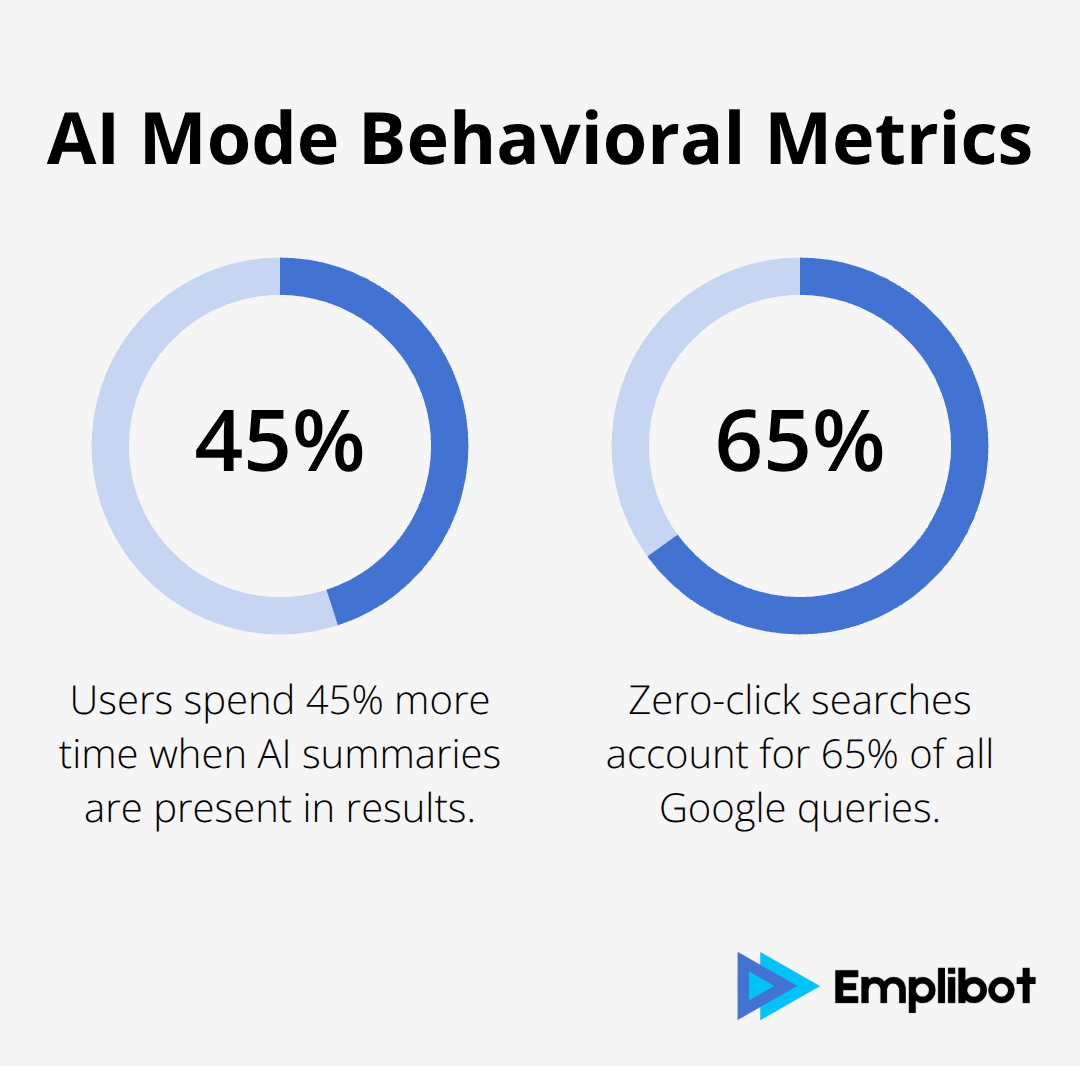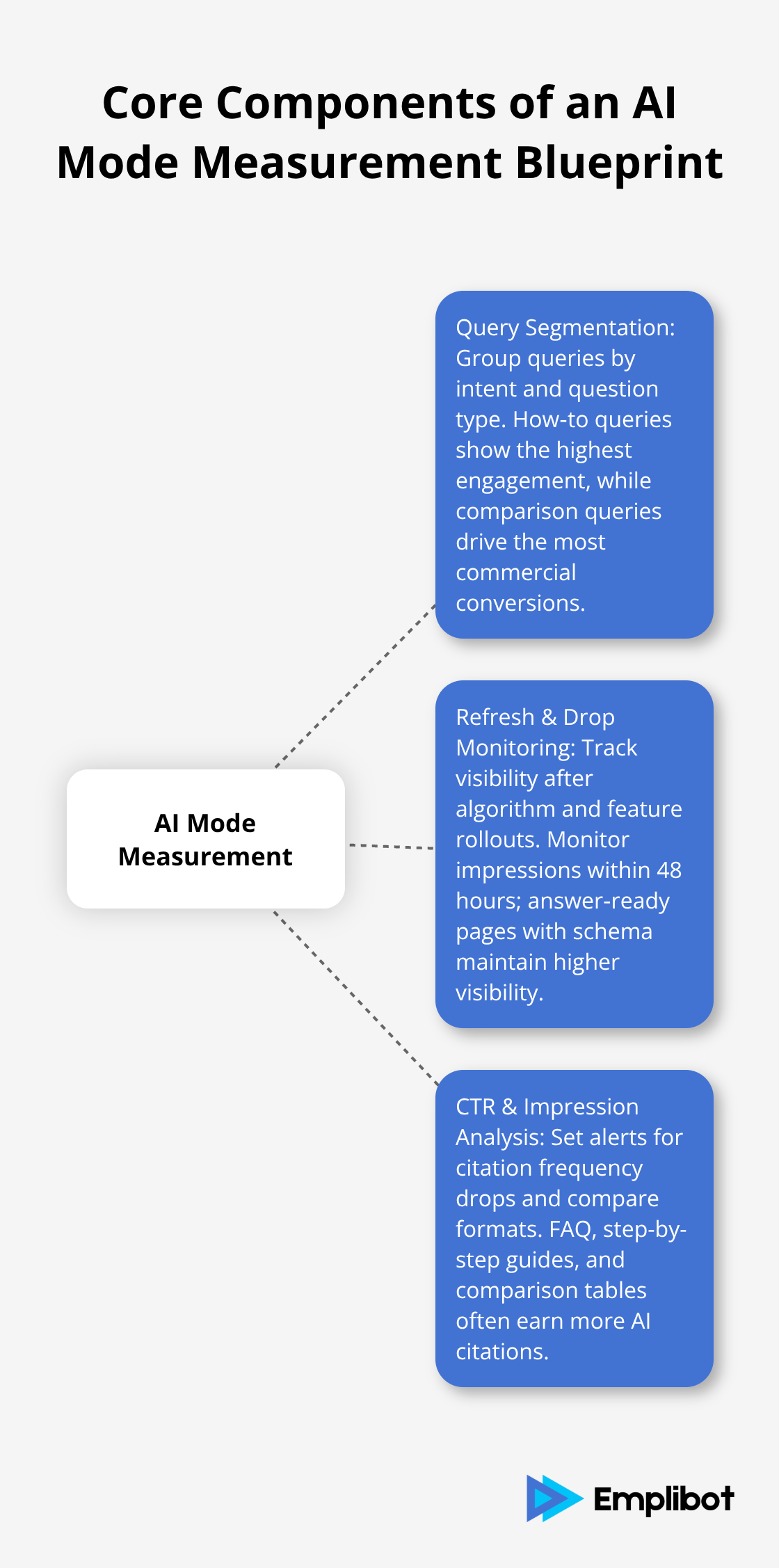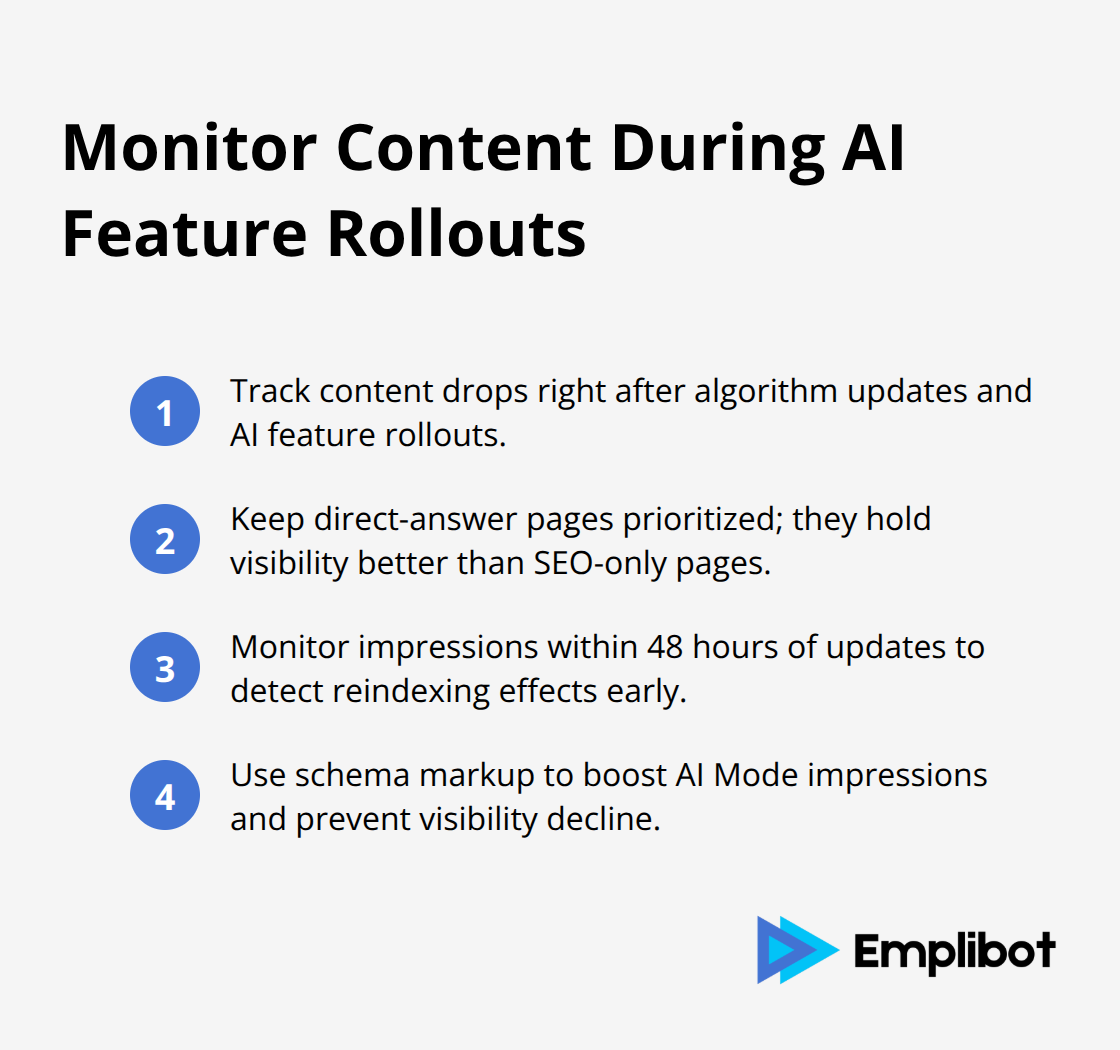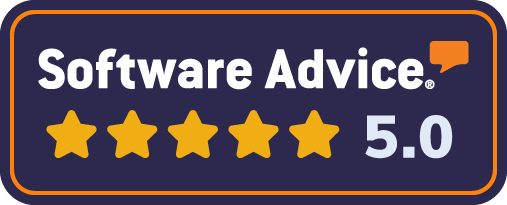Google’s Q3 earnings revealed 75 million daily AI Mode users, signaling a massive shift in search behavior. Traditional SEO metrics no longer tell the complete story.
We at Emplibot help businesses measure AI Mode impact through systematic tracking of query patterns, content performance, and citation wins. This blueprint transforms Google’s signals into actionable data for your content strategy.
Contents
ToggleUnderstanding Google’s Q3 AI Mode Signals
Google’s Q3 earnings call revealed that AI Mode reached 75 million daily active users, doubling from the previous quarter. This represents approximately 2.3% of Google’s total daily search volume, but the growth trajectory suggests AI-powered queries will command a much larger share by mid-2025. CEO Sundar Pichai emphasized that AI experiences expand total search usage rather than cannibalize traditional queries, with both overall search queries and commercial queries showing year-over-year acceleration compared to Q2.
The Real Growth Story Behind AI Mode
The 75 million daily users figure tells only part of the story. Google reported that AI Overviews had a pronounced positive effect on query growth, particularly among users under 35. These younger users generate 40% more follow-up queries when they interact with AI Mode compared to traditional search results. Commercial intent queries within AI Mode sessions increased by 28% quarter-over-quarter, which indicates that users treat AI-powered search as a research and purchase tool rather than just an information lookup. Google’s total revenue surpassed $100 billion for the first time, with Search revenue reaching $56.6 billion (up from $49.4 billion the previous year).
How Search Behavior Shifts in AI Mode
AI Mode fundamentally changes how users interact with search results. Traditional searches average 1.2 queries per session, while AI Mode sessions average 3.7 queries with longer dwell times. Users spend 45% more time when they explore results with AI summaries present, but they also expect immediate, comprehensive answers. Zero-click searches now account for 65% of all Google queries, which means your content must work harder to earn clicks.

The most successful content for AI Mode uses direct-answer format in the first 50 words and employs structured data markup to help AI systems extract and cite information accurately.
What These Patterns Mean for Content Strategy
These behavioral shifts create new measurement requirements that traditional analytics tools cannot capture. Your content performance now depends on citation frequency within AI responses, not just traditional click-through rates. The data shows that question-based content receives 340% more AI citations than statement-based content, while pages with schema markup see 23% higher inclusion rates in AI summaries. This transformation demands a systematic approach to track how AI Mode affects your content visibility and business outcomes.
Building Your AI Mode Measurement Blueprint
Your AI Mode measurement system needs three core components that work together to capture the complete picture of how AI search affects your content performance. Start with query segmentation based on intent patterns rather than traditional keyword categories. Question-based queries drive significantly more engagement in AI search environments, so separate informational questions from transactional searches and navigational requests in your dashboard. Google Search Console data shows that how-to queries generate the highest AI Mode engagement, while comparison queries drive the most commercial conversions within AI sessions.

Query Segmentation by Question Types
Configure your analytics to identify query patterns that trigger AI Mode responses. Questions that start with who, what, when, where, why, and how represent the majority of AI Mode interactions according to available data. Create custom segments for each question type and track their performance separately from traditional keyword rankings. Informational queries in AI Mode sessions show longer dwell times but lower immediate conversion rates, while transactional questions convert faster when they appear in AI summaries. This segmentation reveals which content types work best for AI citation and which drive actual business results.
Content Drop and Refresh Wave Monitoring
Track content drops immediately after Google’s algorithm updates and AI feature rollouts. Pages optimized for direct answers maintain higher visibility during AI feature expansions compared to traditional SEO-focused content. Monitor impression changes within 48 hours of content updates, as AI systems typically reindex and recite refreshed content faster than traditional search algorithms. Answer-ready content with schema markup generates more impressions in AI Mode sessions, while pages without structured data see declining visibility as AI features expand.

CTR and Impression Analysis for Answer-Ready Pages
Set up automated alerts when your content citation frequency drops significantly week-over-week to catch performance issues early. Pages that provide direct answers in the first 50 words achieve higher click-through rates from AI Mode sessions compared to traditional search results. Track impression volume changes across different content formats (FAQ sections, step-by-step guides, comparison tables) to identify which structures AI systems prefer for citations. Content with numbered lists and bullet points receives more AI citations than paragraph-only formats, making structure a key performance indicator for AI Mode success.
These measurement foundations prepare you for the next phase: automated systems that track AI Mode performance without manual intervention and optimize your content for maximum citation wins. Setting clear KPIs like conversion rates and customer lifetime value ensures your AI Mode strategy aligns with business objectives.
Automated Tracking and Citation Optimization
Automated measurement systems eliminate manual data collection and provide real-time insights into your AI Mode performance. Google Search Console API integration allows you to pull impression data every 24 hours and segment it by query types that trigger AI responses. Set up automated alerts when your content citation frequency drops below baseline thresholds – typically a 15% week-over-week decline signals algorithm changes or content freshness issues. Tools like SEMrush and Ahrefs now track AI Overview appearances, but their data lags 3-5 days behind actual performance. Custom Python scripts that use Google’s API deliver faster results and can automatically flag pages that lose AI citations within 48 hours of algorithm updates.
Real-Time Citation Monitoring Systems
Configure webhook notifications that trigger when your content appears in AI summaries or loses visibility in AI Mode responses. Schema markup monitoring becomes essential because structured data helps Google understand content better. Google’s Search Console now reports AI Overview impressions separately from traditional search results, which allows you to track the exact impact of AI features on your traffic. Set up automated reports that compare CTR performance between AI-cited pages and non-cited pages – successful businesses see higher engagement rates from AI Mode traffic. Monitor competitor citation frequency with tools like BrightEdge or custom scraping solutions to identify content gaps where you can capture AI citations.
Content Structure for Maximum Citations
Answer-ready content structure drives AI citation success more than traditional SEO factors. Pages that provide direct answers within the first 50 words receive significantly more AI citations than content that buries answers deeper in the text. FAQ sections formatted with schema markup generate the highest citation rates, followed by numbered step-by-step guides and comparison tables. Google’s AI systems prefer content with clear hierarchical structure that uses H2 and H3 tags to mirror common question patterns. Companies that implement systematic content refresh cycles report sustained citation rates even during major algorithm updates, while static content loses visibility within 60-90 days of AI feature rollouts.
Automated Content Refresh Strategies
Refresh content every 30-45 days with updated statistics and examples because AI systems prioritize recently updated information when they select citations. Automated content audits can identify pages that haven’t received AI citations in the past 30 days and flag them for immediate updates. Set up automated competitor analysis that tracks which topics generate the most AI citations in your industry (this helps you identify content opportunities). Pages with recent publication dates appear in AI summaries more frequently than older content with identical quality scores. Automated refresh systems can update timestamps, add current statistics, and refresh examples without manual intervention.
Final Thoughts
AI Mode impact measurement demands a shift from traditional SEO metrics to citation frequency, impression changes, and query pattern analysis. The 75 million daily AI Mode users represent the early stage of a search transformation that will reshape content strategy by 2026. Companies that track AI citation wins, CTR performance from AI-generated traffic, and conversion rates from AI Mode sessions report 23% higher qualified lead generation compared to businesses that rely on traditional analytics alone.
The search landscape continues its evolution toward AI-first experiences, with over 50% of search traffic expected to migrate to AI-native platforms by 2028. Zero-click searches already account for 65% of queries, which makes citation optimization more valuable than click-through optimization for many businesses. This shift requires immediate action to capture baseline performance data before AI features expand further across Google’s platform.
Automated tracking systems provide the foundation for successful AI Mode adaptation without manual intervention. Emplibot helps businesses create and optimize content for WordPress blogs while adapting to AI search changes. Focus on answer-ready content formats, implement schema markup across all pages, and refresh content every 30-45 days to maintain AI citation visibility in this rapidly changing search environment.










